The Samsung Galaxy S6 and S6 edge Review
by Joshua Ho on April 17, 2015 9:00 AM EST- Posted in
- Smartphones
- Samsung
- Mobile
- Galaxy S6
- Galaxy S6 Edge
System Performance
In order to test the Exynos 7420 and the phone in general, we turn to our suite of benchmarks which are able to show how the device performs in common general computing workloads. Something as simple as web browsing is still surprisingly intensive on mobile phones, and in general Android can often be quite stressful to run in the constraints of a ~3W total TDP especially on any phone still running Dalvik due to its strong reliance on bytecode and a virtual machine that translates bytecode to machine code just before and during application runtime. ART improves this significantly, but is limited in the nature of optimization as AOT compilation optimizations are limited by the CPU power of the SoC and the need to compile the application in a reasonable amount of time.
As always, we'll start things off with our browser benchmarks. After getting to use the phone, it became clear to me that Chrome is poorly optimized against the Galaxy S6 as Samsung’s browser is clearly superior in performance. For that reason I've gone ahead and run our benchmarks on both Chrome and on the stock browser, as seen below.

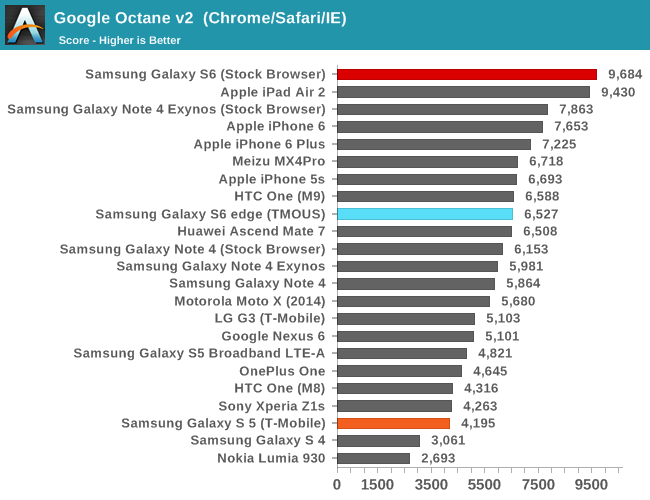

Needless to say, in order to see the full potential of the Exynos 7420 and its cluster of A57s, it’s necessary to use Samsung’s stock browser. This performance is really quite amazing when compared to Apple’s A8X, which has basically been the gold standard for performance in the mobile space in the context of ARM SoCs.
Moving on, as a part of our updates to the benchmark suite for 2015, we'll take a look at Basemark OS II 2.0, which should give a better picture of CPU performance in addition to overall device performance.
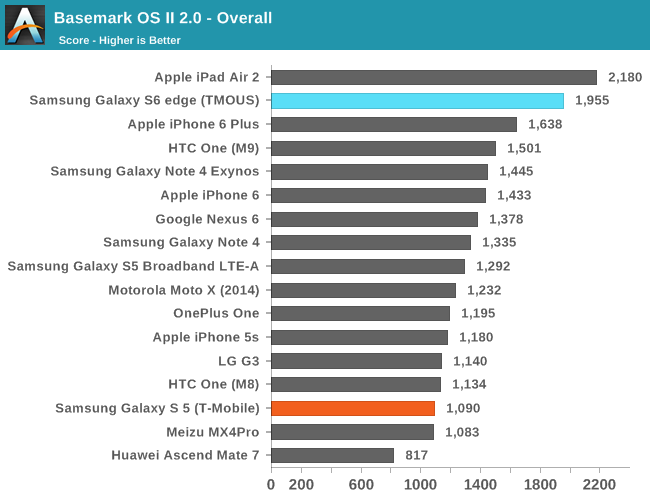
The browser benchmarks seem to hide some pretty enormous variability as the Galaxy S 6 edge (which is comparable to the Galaxy S 6) sets a new record among Android devices. The only challenger is the iPad Air 2, which uses the A8X SoC with three Enhanced Cyclone cores and the semi-custom GXA6850 GPU.
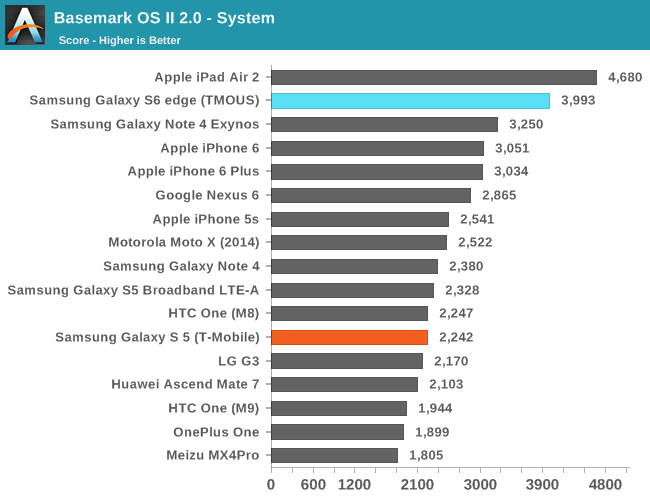
This system test contains a floating point and integer test, in addition XML parsing, which means that this test mostly stresses CPU and RAM. Interestingly enough, the Exynos 7420 pulls far ahead of both the Exynos 5433 and Snapdragon 810 in this test, and approaches the A8X. The difference between the 5433 and 7420 is likely a combination of the higher clocks on both the A57 and A53 clusters for the 7420 (1.9/1.3 on the 5433, 2.1/1.5 on the 7420), in addition to the ability to stay at a high 'overdrive' clock due to reduced leakage from the 14LPE process. The One M9 likely falls a bit short here due to HTC's governor settings restricting the use of all 8 cores simultaneously.

While one might guess that the memory test of 'Basemark OS II 2.0 - Memory' is of RAM, this is actually a test of the internal storage. Once again we see the S6 edge come close to leading the pack due to the use of the new UFS (Universal Flash Storage) standard. Casual examination reveals that the S6 edge has a queue depth of 16, and that it identifies itself with the rather cryptic model name of KLUBG4G1BD-E0B1.
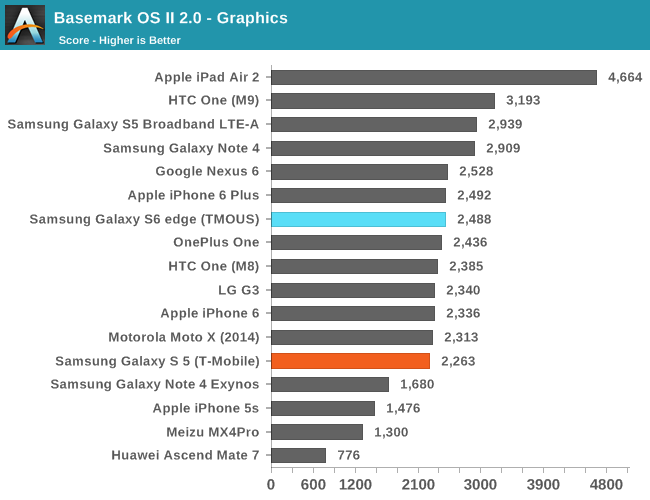
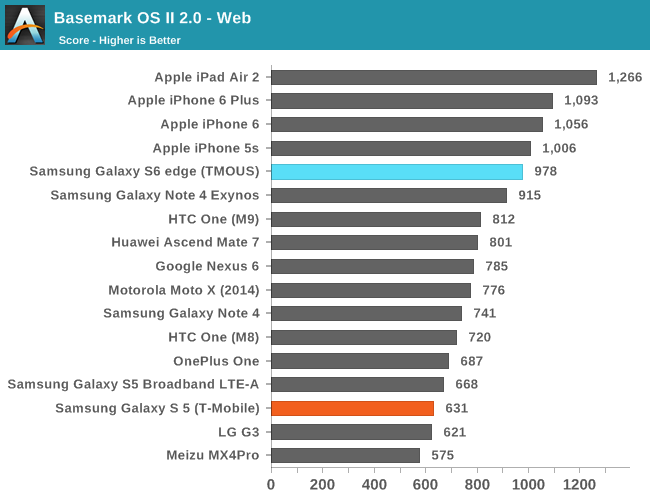
For the web test, it uses the built-in WebView rendering engine rather than Chrome and paints a distinctly different picture, especially because these tests are focused on HTML5 and CSS rather than JavaScript. Here we can see that the iPhone 6 and iPad Air 2 continue to hold their lead, but the Galaxy S6 is pretty much the king of the hill when it comes to Android devices.
Our next system benchmark is PCMark, which does a number of basic benchmarks designed to stress various aspects of the device in everyday workloads like video playback, web browsing, text editing, and photo editing. This tends to test every aspect of a mobile device, unlike microbenchmarks that can often miss aspects of the system that can affect performance.
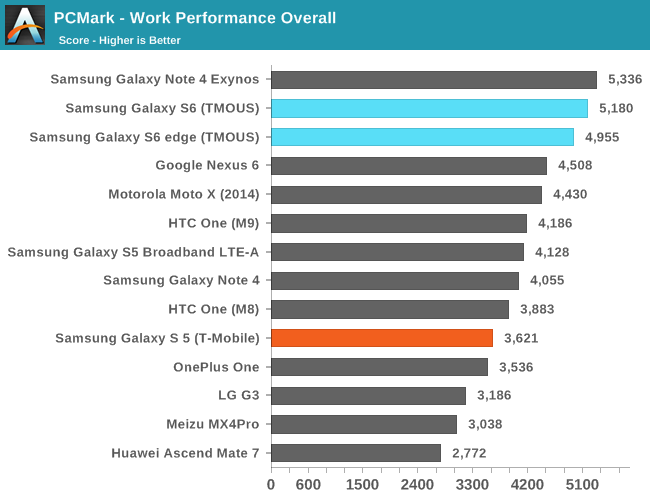
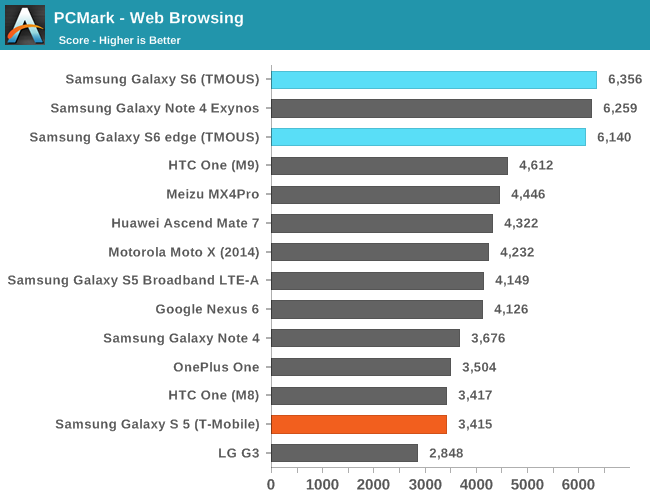
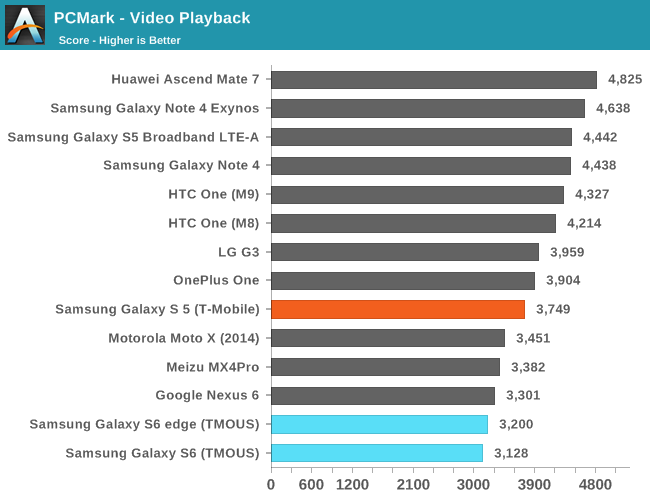
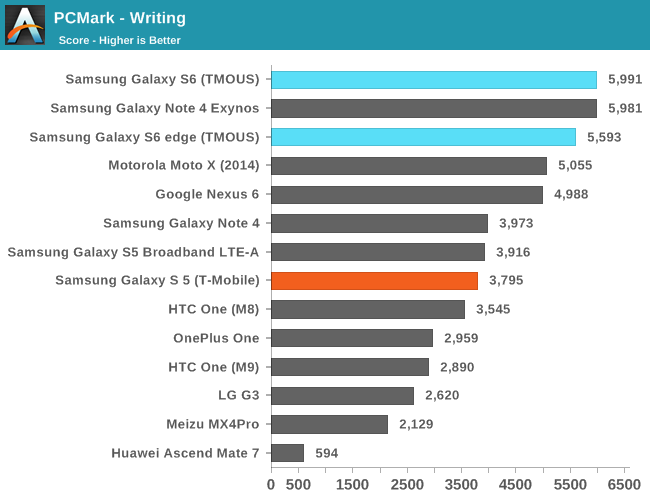

In these tests, the Galaxy S6 continues to perform strongly here due to the fast NAND storage solution and the Exynos 7420 SoC. As we have already covered the Basemark OS II 2.0 results in previous articles, I would refer back to it as those scores are final and have already been contextualized.
Overall, in these general purpose computing tasks that stress CPU, memory, and NAND performance we can see that the Exynos 7420 is off to a flying start. Samsung Mobile should focus more strongly on optimizing the software stack against Chrome as mobile Chrome has around twice the user share of stock Android browsers. I often say that the SoC is the foundation to a good smartphone, and in the case of the Galaxy S6 it feels like this is especially true.










306 Comments
View All Comments
FlushedBubblyJock - Friday, April 24, 2015 - link
so the pictures go by default to internal memory - that's one red herring out with the bathwater ...lag and power drain - I guess android is so stupid the 1st thing it does when you touch your metal feel, is scan the sd card for desperately needed data, right ?
yes, twin babies out with the bathwater fella - right out the window an onto the sidewalk below
h3ck - Friday, May 8, 2015 - link
How is removing the sdcard more "iPhone-like" when Google Android Standard is no sdcard? The flagship Vanilla Android Nexus line is all sans sdcard. I think we often forget that and quickly point to Apple. Also, with increasing harddisk sizes and the ease of using a microsd to microusb adapter (see Dash Micro device), I think the sdcard argument is weak.Daniel S. Buus - Friday, July 17, 2015 - link
Those were my gripes as well. However, as I've learned that the battery is still replaceable, and the charge is $45 for such a replacement done by Samsung, the battery issue doesn't bother me anymore. Then the storage thing — I've previously bought my share of SD cards to augment my phones. The largest card I've bought was a 64GB one, though, which was sufficient in my Note 3 to satisfy my hunger for filming 1080p60 when travelling. I just ordered the S6 128GB version on sale for the same price as the 32GB version, and it's plenty plenty plenty for my needs. I may have to unload some stuff in the evening to an external storage device if I go crazy with my filming, but that's it. Reading this review and seeing the impressive speed of the storage just makes me even happier that I finally chose this phone :)beehofer - Friday, April 17, 2015 - link
Nice Phone. There's nobody who won't take one if it were offered. But since we have to pay, ppl will decide on the things that set it apart from the pack. Samsung had an "edge" with SD cards and removable batteries and for some of us it will be a deciding factor. The battery, OK I'll get an extra charger for the car or office but the SD is inexcusable. This has ALWAYS been a blow against Apple and now it can be said against Samsung. I'll keep my S5 or wait.name99 - Friday, April 17, 2015 - link
Samsung probably ALSO have sw installed on the phone that tells it when an SD card has been installed and the battery replaced, and is well aware that <1% of their phones ever went through either operation.I suspect Samsung's idea of what matters to the market is rather more accurate than your idea...
FlushedBubblyJock - Friday, April 24, 2015 - link
I believe you are referring to the NSA, and thus, with no removable battery, the phone can never really be "turned off" and no removable SD means Homaleand Security and the NSA can access you and everything you've done at any time....So, it's truly and upgrade because you of course have nothing to hide
akeemcharles - Friday, April 17, 2015 - link
Nice photosUxi - Friday, April 17, 2015 - link
I have an S5 with wireless charging using original Samsung covers, so wireless charging is not N/A on the S5, but I admit it was an add-on purchase.DanNeely - Friday, April 17, 2015 - link
What is the "obvious" defect on the S6 screen picture? Is it one of the things that looks like a fingerprint smudge, the horizontal blue bar that looks like a reflection, or something that isn't obvious to me from looking at the picture?nerd1 - Friday, April 17, 2015 - link
I have a phone with exactly the same display (Galaxy S5 cat.6 model) and couldn't see any 'obvious' defects at all.